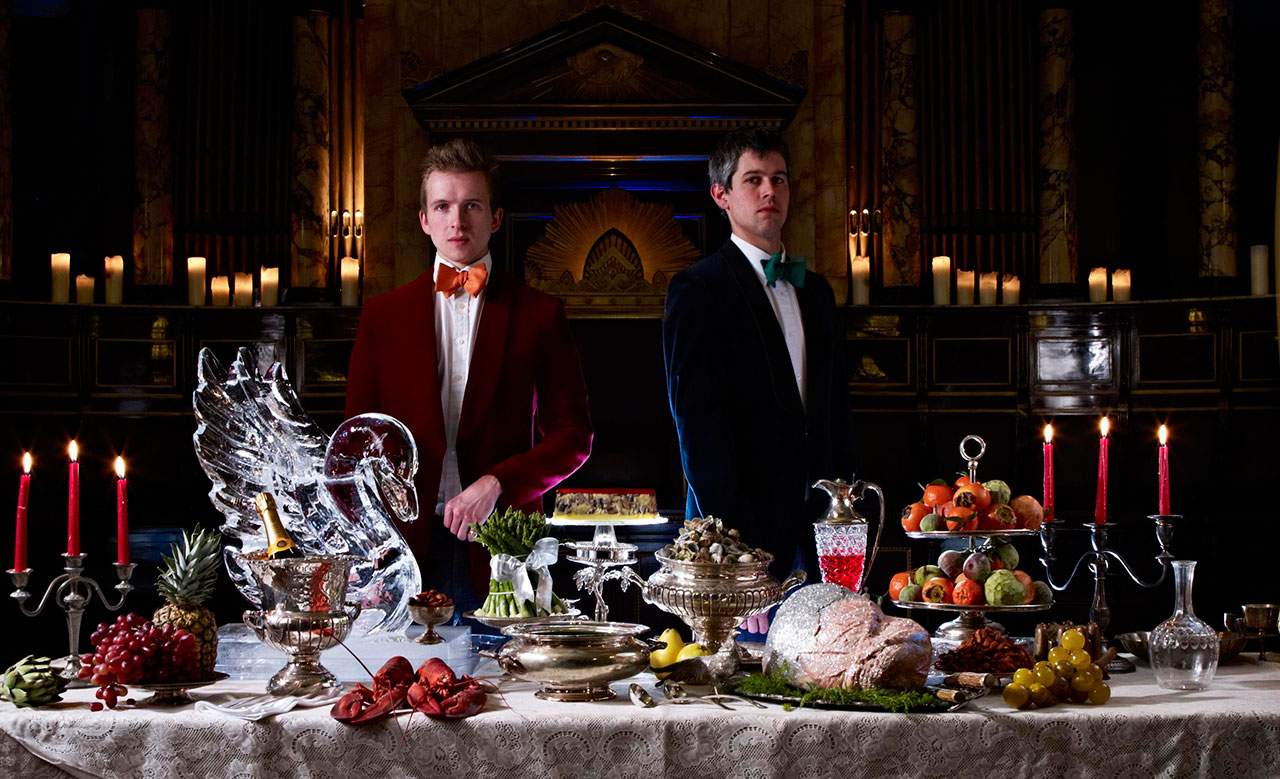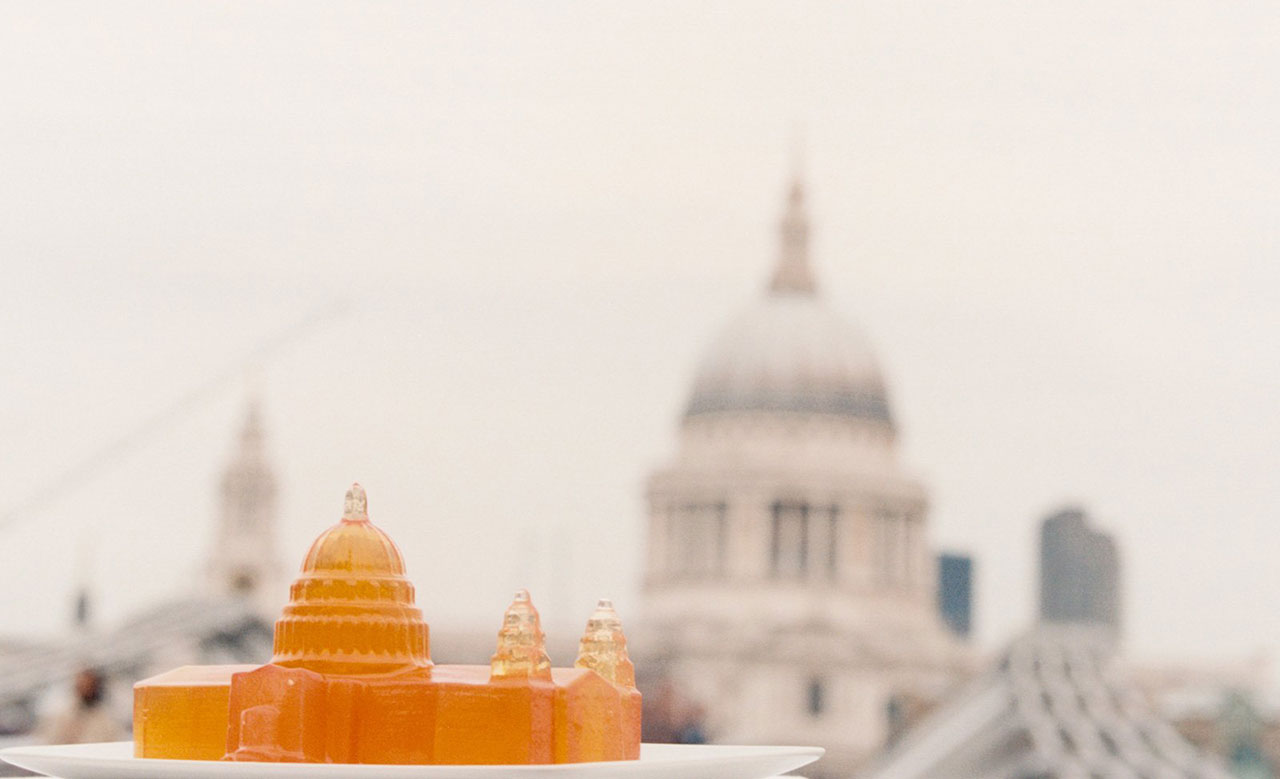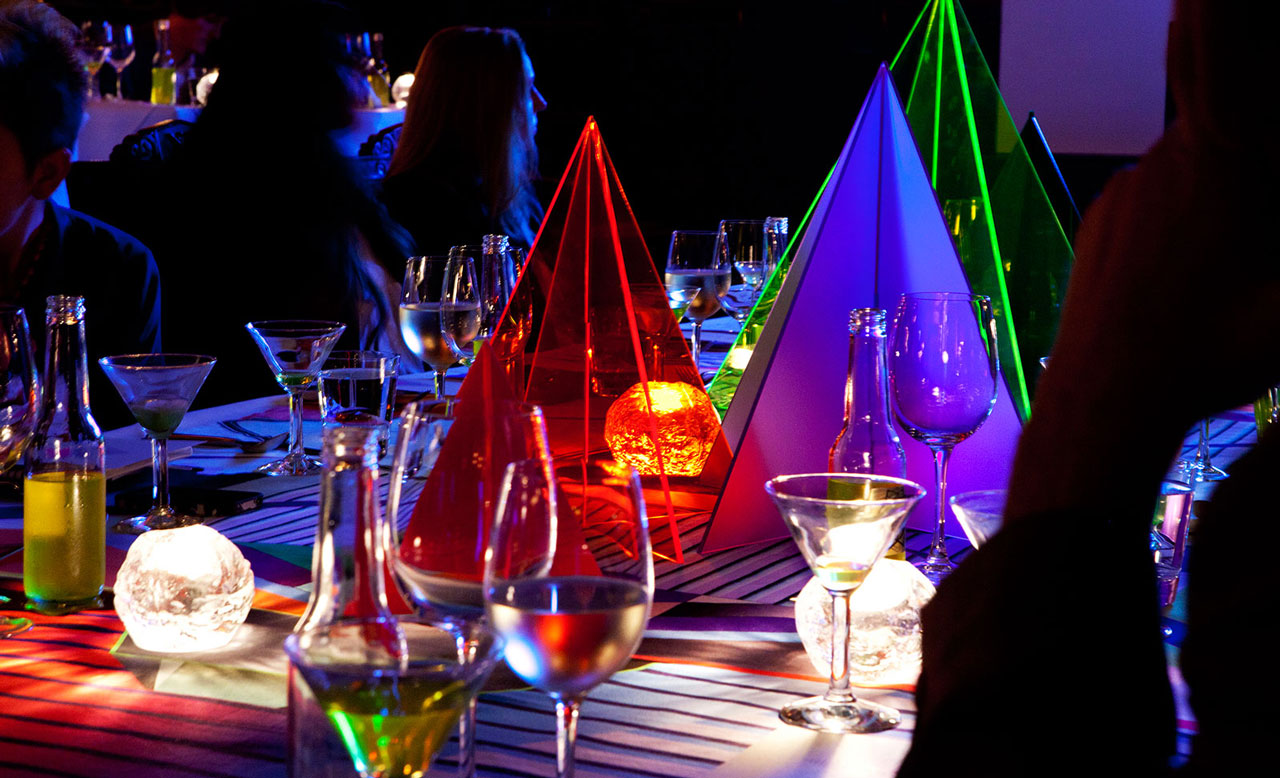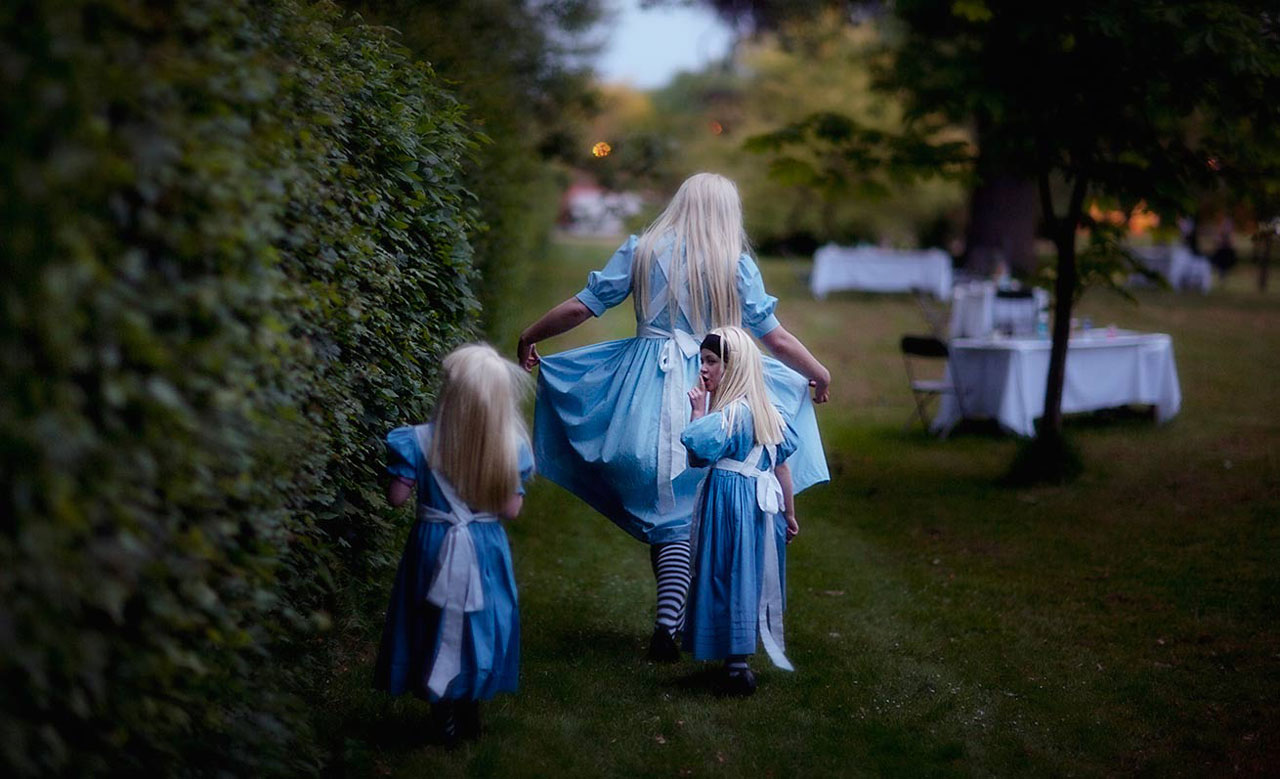Talking Food Culture with Jellymongers Bompas & Parr
Sam Bompas on animal instincts, Australian food trends and whether you should eat the Vegemite chocolate.
They send coffee beans into space, shoot fireworks you can taste into the sky and make cocktails tailored to your individual DNA in Dubai. With their fantastical fusion of art and food, UK-based 'jellymongers' Bompas & Parr are basically our patron saints around the Concrete Playground office. Who wouldn't want to attend one of their playful and painstakingly constructed events?
For the happy campers at Dark Mofo, that's what's set to happen in a big way. As part of the Unconscious Collective's art sleepover Wild at Heart, the duo will create a feast that nods to Pagan traditions through hunting, gathering, sacrifice, ritual and some intensely primal dishes. With our eyes wide and mouths properly drooling, we got Sam Bompas on the line for a lowdown on what to expect at his Feed the Beast feast. And even more than that, we wanted to know what a person so used to thinking laterally about the potential of food has to say about current dining trends and the Australian culinary scene. His answers may surprise you.
You and Harry [Parr, the other half of Bompas & Parr] started working together as jellymongers, but I see increasingly more stories about non-jelly-related experiences you've created these days. How did that evolution happen?
I think quite naturally. When we started out we just wanted to do something fun on the weekend, and jelly held the key. We set up the jelly company but within a month we were moving on to full catering, doing a 12-course Victorian breakfast in Warwick castle, coordinating a thousand calories arriving on people's plates from three separate kitchens. So we moved quite quickly from jelly into doing everything. And I think really the reasoning behind that was wanting to give people really engaging, emotionally compelling experiences and in order to do that we were looking at controlling everything, from venue and set design to uniform design to choreography, rituals, scripting, staff, right through the plates and everything else. So I guess it was pretty ambitious.
Obviously it takes a much bigger team of creatives to make all of this happen. Is your workplace basically Wonka's Chocolate Factory?
Like that, but perhaps a little more adult. A lot of the projects we work on, some of them are very, very child-friendly — so we just did something that Willy Wonka would be proud of, a flavour-changing chewing gum factory — but some of the projects are a lot more adult, so things like the installation we've got up at the Museum of Sex in New York at the moment, which is looking at fairgrounds and eroticism, the pleasures and perils of the erotic fairground.
You've been to Australia a few times now with your work. What did you find out about Australian food while you were here?
I've got to say, when the Australian chefs I know come over to London, I'm always very, very interested because I think that in certain sectors Australia leads the world by about six months or so, in things like juicing culture, coffee culture, a lot of their F&D, and I'm obviously interested in some of the more unusual ingredients as well which are just totally native to Australia ... I was amazed last time I came across, I went to Africola, the restaurant in Adelaide, and I was served up a whole cow's head with brains still in, and of course, coming from England that's about the most taboo food you could ever imagine, in the aftermath of BSE [mad cow disease], so that was a pretty feral dining experience for me and absolutely blew me away.
That's great for us Aussies to hear, because we have this cultural cringe, where we presume everything we do is a bit backwards. Did your visit give you any ideas you wanted to pursue?
Seeing the cow's head sparked us to push even further what was totally acceptable for us to put on the table.
Everyone here is obsessed with what is called the 'unholy union' of Cadbury chocolate and Vegemite. Have you heard about this?
Oh wow. Not at all. Who claims to have discovered this?
Cadbury's produced it. It's on the shelves.
Really? They're very innovative.
I guess so. We're just discovering how deep their imagination can stretch. So would you eat Vegemite chocolate?
I'm never shy to try something once.
Most people's reaction is 'yuck'. So is that yuck impulse something you like to trust, or interrogate?
Well I think it's always culturally constructed. I've read a lot of research that says you can grow to like anything after you become acclimatised, and actually grow to love it. So once you know that, then you're kind of up for eating anything. Quite often when I travel my host will try to put the most harrowing things on the table just to test me, but I always quite like that challenge. So whether it's live, squirming tentacles that if you don't chew them stick to the back of your throat in South Korea or strange and rare fruits in Hawaii, I love pushing what I feel are my own limits.
Insects are starting to become a thing here. You've probably eaten a few insects in your time?
Yeah. There's a lot of chat about it. We did a whole insect banquet as part of something around Indiana Jones and the Temple of Doom, god, four or five years ago now. I'm not convinced insects are the future for our diets but I do think that they might help with animal feed and animal protein. I'm much more interested in the creative potential of genetic manipulation.
I did imagine that you would be more excited than worried about GM.
Well of course there are ethical concerns but as long as you navigate them in a sensible and conscientious manner I think there's some good work to be done.
Back to the present. There's also this rise at the moment in food that's a challenge. You know, it's either impossible to make, or it's some kind of monstrous hybrid, or it looks like it could give you a heart attack. What is that about do you think? And do you see that kind of instinct in people as fuelling interest in your own work?
I think for me, it's feeding into how across the board people are using food to define their personal sense of identity and to perform identity in front of others as well. So whether that's you're eating your glucose-free, lactose-free light salads and you're telling the story to people of you as a yoga babe, or savage dude food — all of it, of course, going up on Instagram to tell people what an interesting, amazing life you have. And I think it's exciting too. What it has meant is, given that people are using food in this way, as a signifier of status and signifier of identity, there's been an increasing amount of resources put into food and concern about food and what people are eating, and generally an overall lift up in food knowledge, which I think can only be a good thing.
Absolutely. Australia certainly has a big foodie culture. Probably safe to say it eclipses our interest in stuff like art and art appreciation. Your work obviously combines both food and art. So what is the connection you see between the two areas?
Basically no one eats our food because they're in need of more calories — in actual fact, they're often avoiding calories. They tend to eat our food for entertainment, and personally I consider both arts and food offshoots of the entertainment industry. So if you come to one of our events rather than going to the opera, going for a nice swim, making love, sitting at the pub talking about mermaids or whatever you like to talk about, it has to be really rather compelling. I guess one of the good things about food is it's a wonderful arena to give people an interesting and emotive experience and I think that's what the best art seeks to do.
Foodie culture obviously has a lot of benefits — the increased knowledge, as you were saying. But do you think there are any downsides from being too narrowly focused on food?
I think you've got to look at the word 'foodie' itself, is a pejorative term. It was invented in the 1970s by Paul Levy as a descriptive of someone who's too concerned about food to the point of missing other things in life. I think it is important to have balance, but if you look at a lot of our installations, while the food is important, we address a lot of the attention to other elements as well, just to give people a total experience, one that's very legible and understandable. I find sometimes very cheffy food becomes difficult to read; it becomes something that only the food elite can possibly understand. But what I'm interested in is a much more inclusive approach to food.
Your banquet in Tasmania, Wild at Heart, is based around pagan themes. It seems pretty perfect for Dark Mofo, which also includes a nude solstice swim. Is that where the inspiration came from?
With the banquet we've been collaborating with the Unconscious Collective, and they set the theme, but it's a theme we've been very delighted to explore, expand on and run with. It's so hairy and muscular you can really gorge on it, as we hope that participants will be gorging on the feast as well.
There are two components. On the first night, it's more of a gentle, campfire-type scenario, spiced up with flamethrowers, bombfires and roadkill jerky and drinking from actual skull cups hollowed out of a whole variety of animal skulls. And that will actually be up and remain up way beyond the original launch to ensure that everyone can pop down. Then we move on to the Feed the Beast banquet, which is exploring all the many different facets of the beast and the animals we all contain within ourselves.
Sounds primal.
It should be pretty savage. And it's something that I'm quite excited to explore, because when you start feeding people, you become quite aware of just how thin that line of civility is that divides us from the animal kingdom ... So what we want to do with this event and meal is give people the opportunity, the excuse and legitimacy to explore the beast within them, with things [from] blood and beating hearts to epic steaming hunks of spit roast wild deer that's actually just been hunted by [Tasmanian chef] Ross O'Meara to the more amorous side, so exploring tales of aphrodisiacs. There'll definitely be a lot of nudity. And not all of it probably our performers.
One of the things we're looking at is creating an actual beating pig's heart that materialises as part of the starter, and it's literally there pumping fluids around, so it feels very visceral, very alive. We then take this live heart, slice it up and sautee it so it comes back served up for the first course. I don't know that anyone's done that before, so there should be a few world firsts.
Can you tell us anything else you've got planned for the 'rituals' in the event?
We've got lots of rituals around blood. Almost like a whole meditative cleanse around hand washing as well. I'm also very inspired by a chap called Grimod de La Reynière, who was kind of the first proper restaurant critic and if you ask me a far better gourmet and food writer than his contemporary Brillat-Savarin, who everyone normally refers to. And he hosted a very decadent banquet in which all the guests arrived, they had their hands washed, and then they dried their hands on the hair of all the waitstaff, which I think is really, particularly creepy. So we'll try to channel some of those energies as well.
Delightful. I want to ask you about some of your past works that we've covered on the site. You recently held an anatomical whiskey tasting. So I want to know, were people more excited to drink from a 20-year-old or a 50-year-old?
Well we went from 25 to 39, and I think the thing that was wonderful was as the age went up, so the whiskey got more and more elaborate. We actually had a 63-year-old volunteer to be the vessel for one of them, although the only 63-year-old whiskey we could find was going to cost us a hundred and twenty thousand pounds, which got pretty full on ... The thing that I liked was how people interacted with one another. You started off with what was originally a sort of awkward situation, twenty strangers in a room on Valentine's Day, all licking whiskey from the naked, supine body of someone who they've never met and who's just told them the story of their life in fifteen minutes, and even with that, very rapidly, galvanized by some of the world's finest whiskies, they very quickly formed bonds.
What about the lava barbecue? People had to get 500 friends together to make that happen. So did anyone get 500 friends together?
We're still working on that. We're speaking to a couple of people at the moment. That would be my ultimate, ultimate project. That was far and away the best week I've ever had, and far and away the quickest cook as well, given that it is blazing at one thousand three hundred and fifty degrees Celsius.
So you just need to find someone who can gather 500 people?
Five hundred people and quite a hefty budget.
500 people and much money. We'll work on it. And with regards to jelly, have you come across a building you couldn't make into jelly, or are there buildings that work better than others?
Modern architecture doesn't work; anything with a steel core doesn't work particularly well. Towers don't work very well at all. They obviously look phallic as buildings, but even more so when rendered in jelly. We made the Empire State Building and it had to get pulled from American morning television because it was just way too threatening ... But actually the buildings that tend to work best are historic stone architecture. And the reason for that is that as it gets higher then it goes in at the top, and that gives jelly just the right amount of stability. So some of the really good jellies we've made are actually Flinders Street Station and the Melbourne War Memorial, which was a really good one.
But the Sydney Opera House might be harder?
It sort of tapers in at the top; it works quite well. That's a firm favourite and regularly made as jelly.
You already sell 'space beans' [coffee beans that have travelled to space] on the site. Are there any plans to expand the products people can buy?
We often have plans we're not totally good at realising. To do products you have to have a firm focus and keep on rolling on it for a good long while. The inception and the creative frenzy of the first bit is soon replaced by actually having to go out and sell the product. The bit we like doing is all the creative bits, which is why I guess we stick with events and things.
That's reasonable. But we'll keep our fingers crossed for some kind of amazing chocolate bar.
It would be fun to do. I guess we've just got way too short attention spans so far.
Wild at Heart is part of the festival Dark Mofo, which is on from June 12 – 22 in Hobart. The event is sold out, so if you don't have a ticket, you'll just have to watch your friends go savage from afar.









